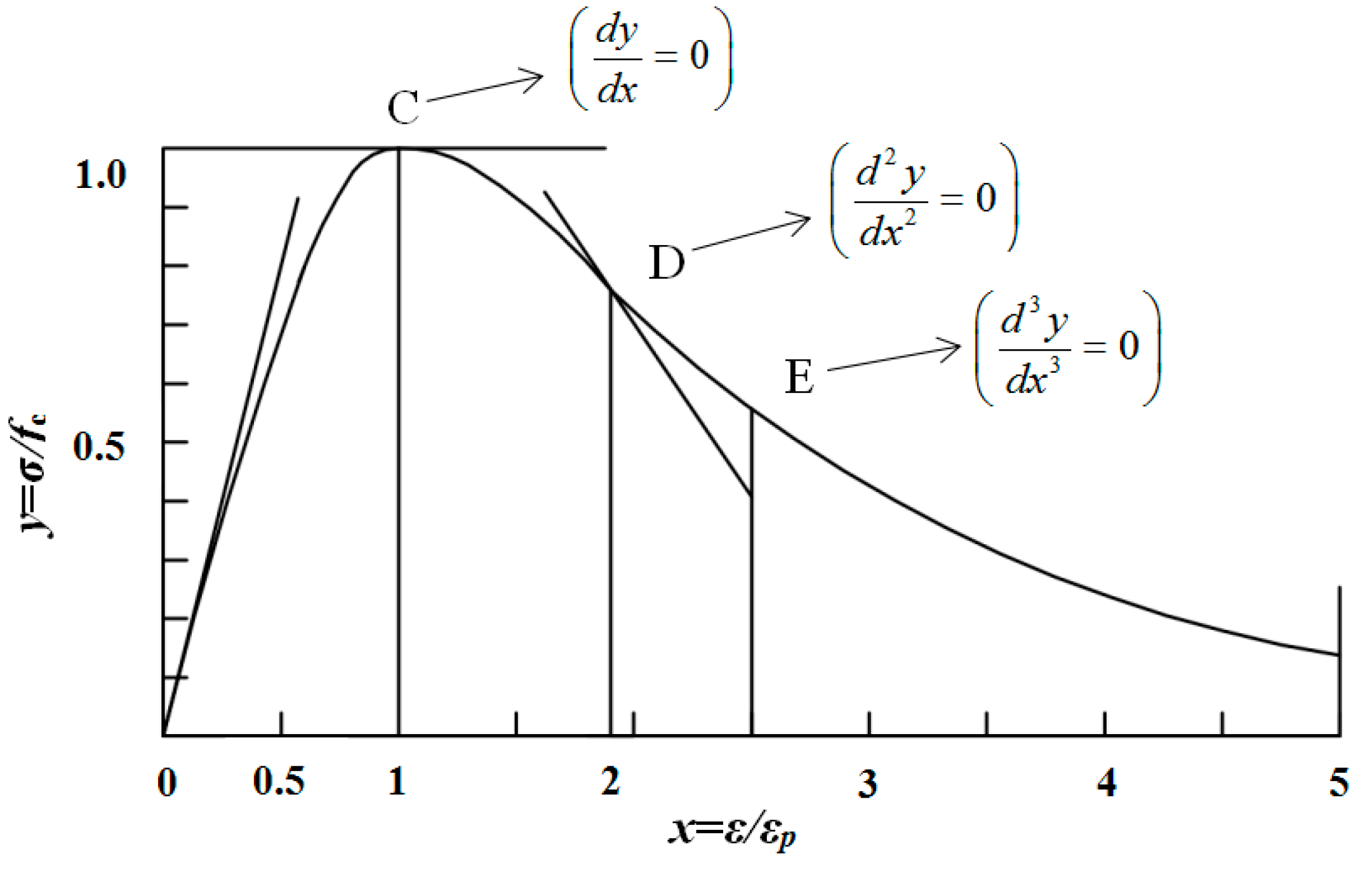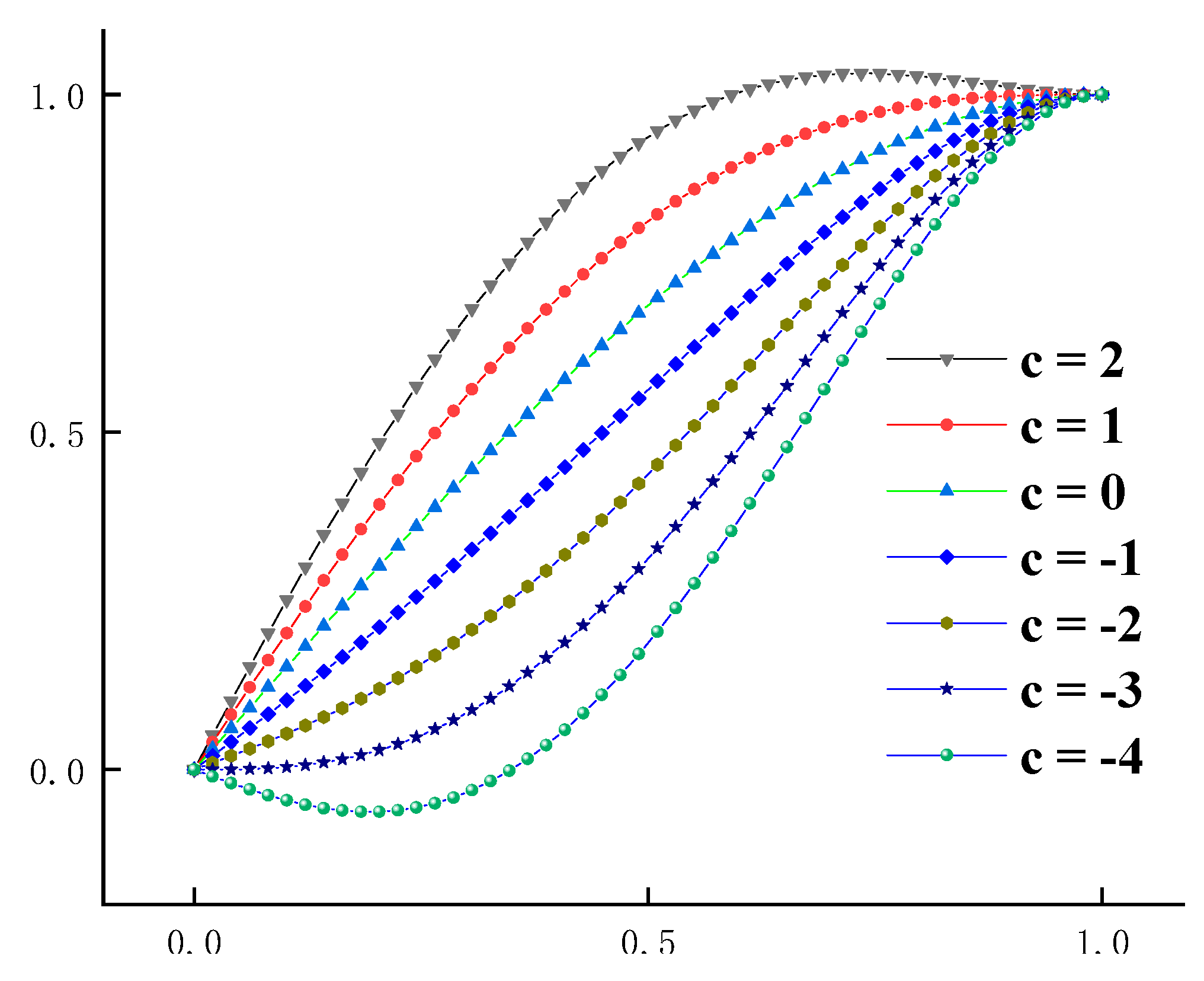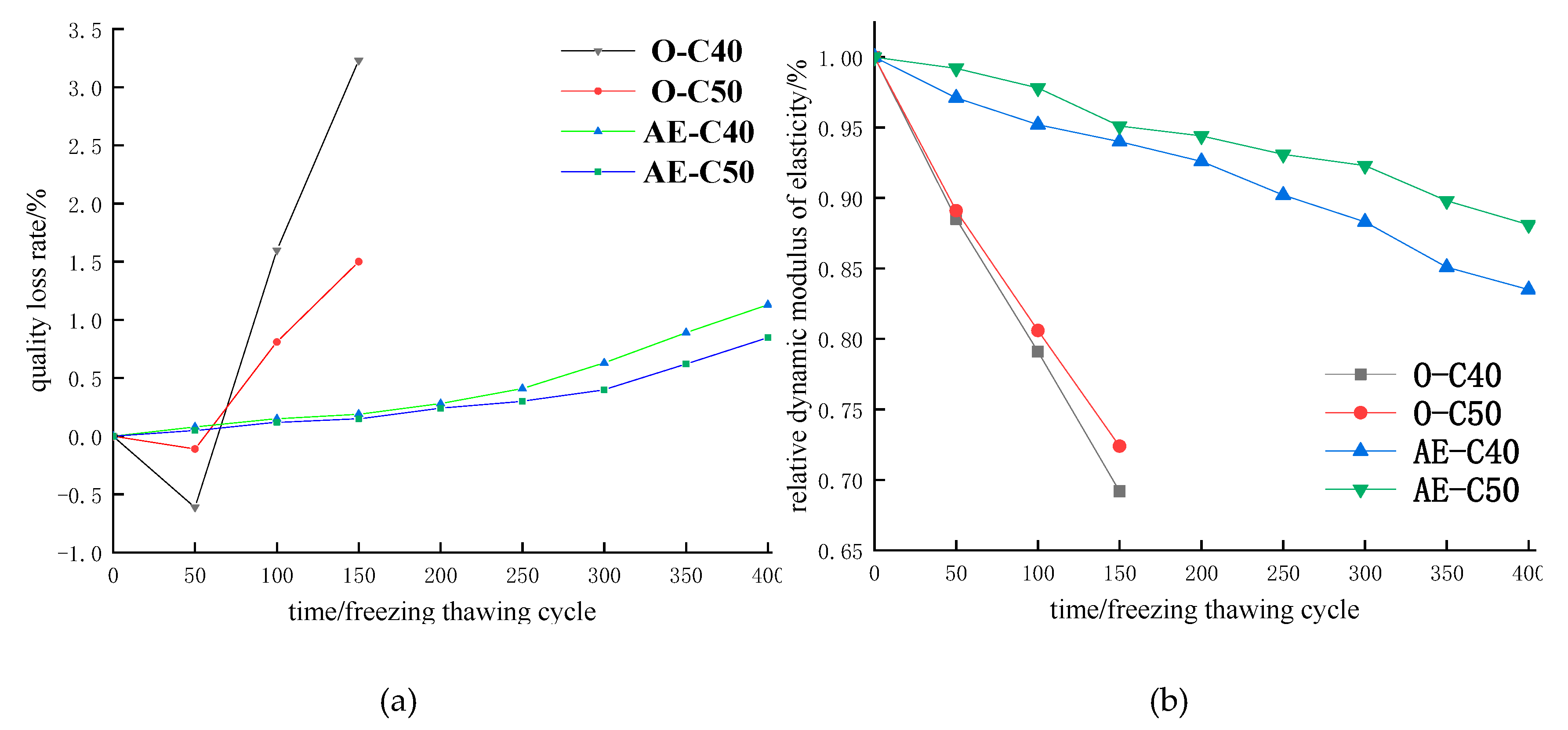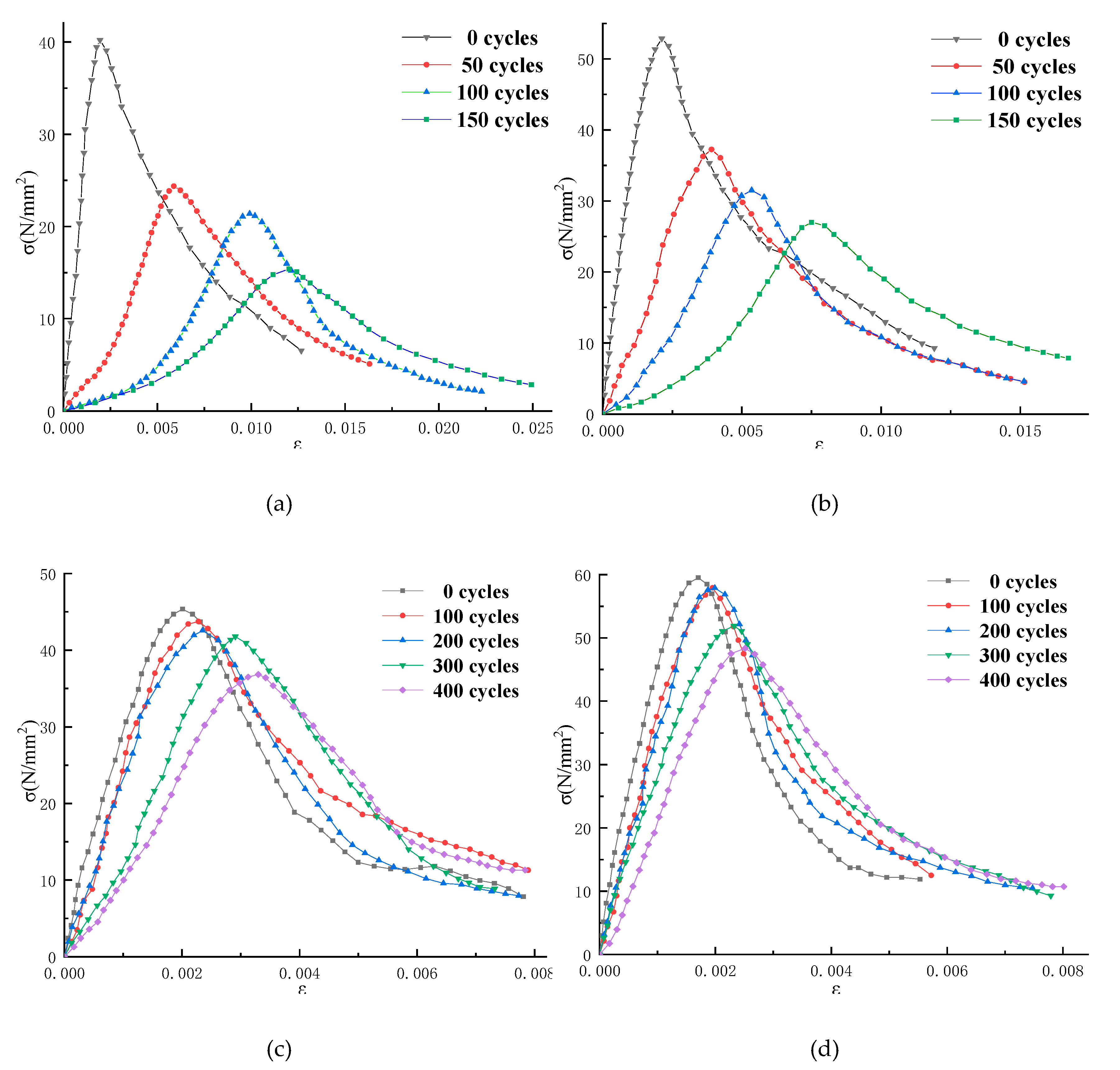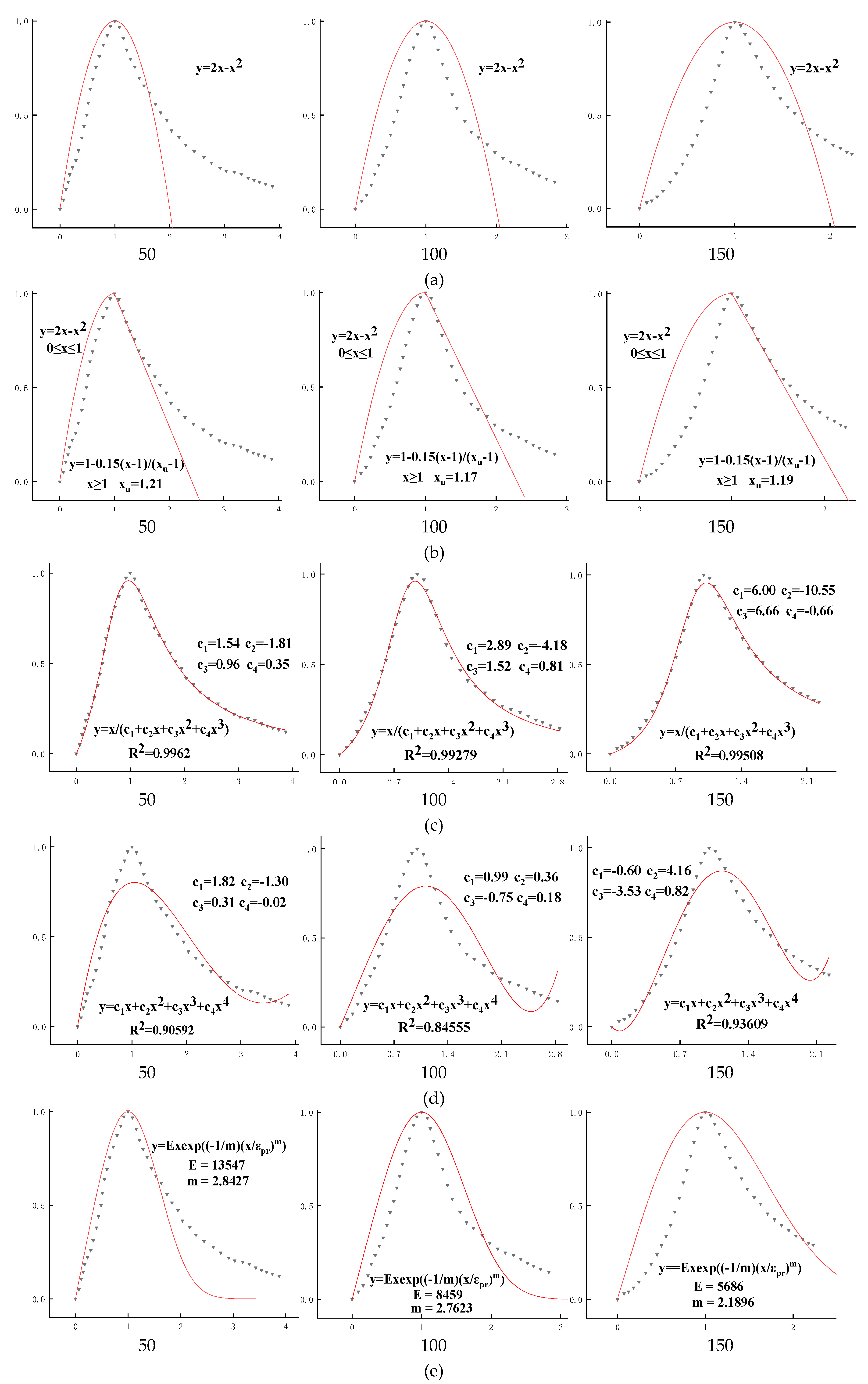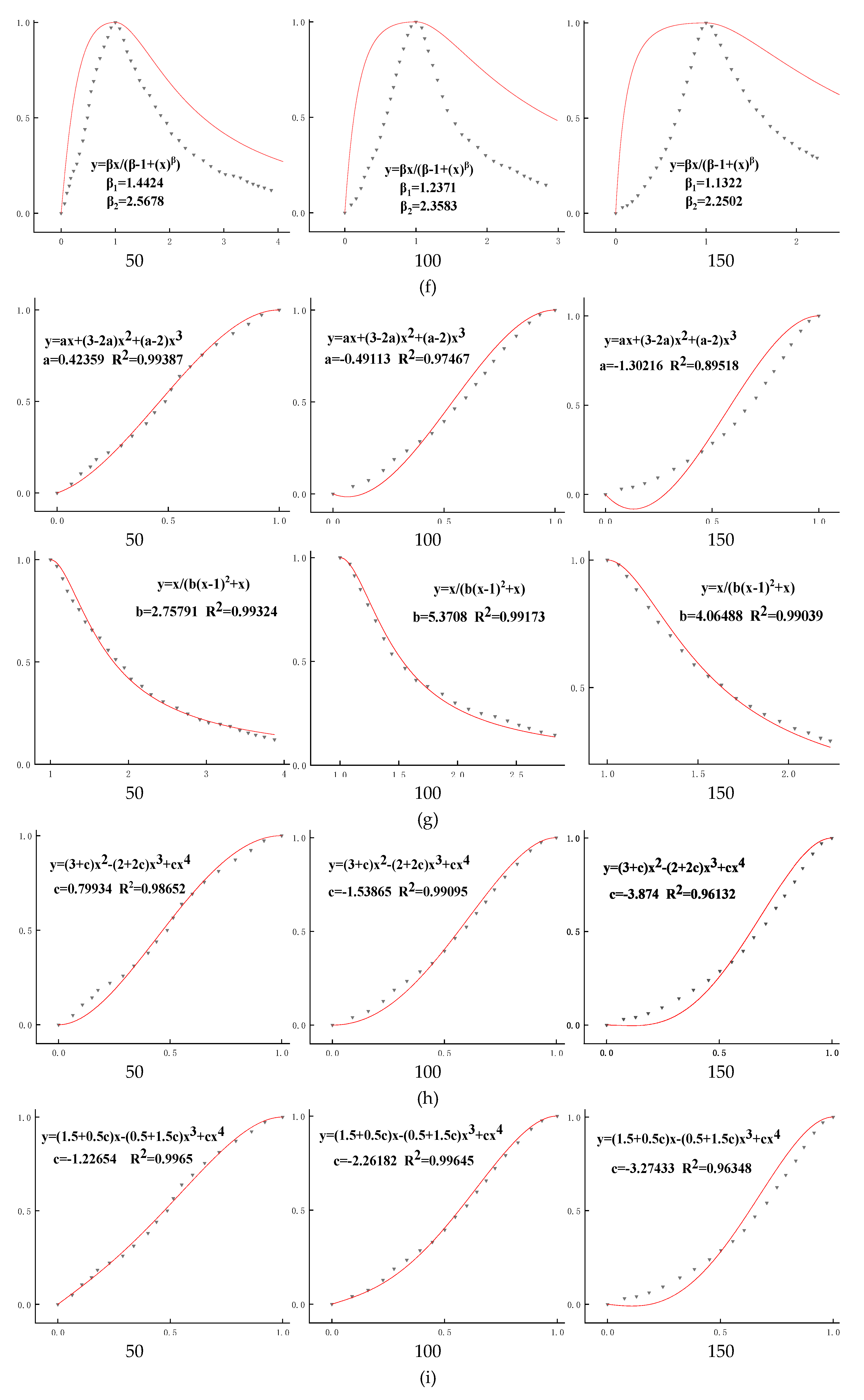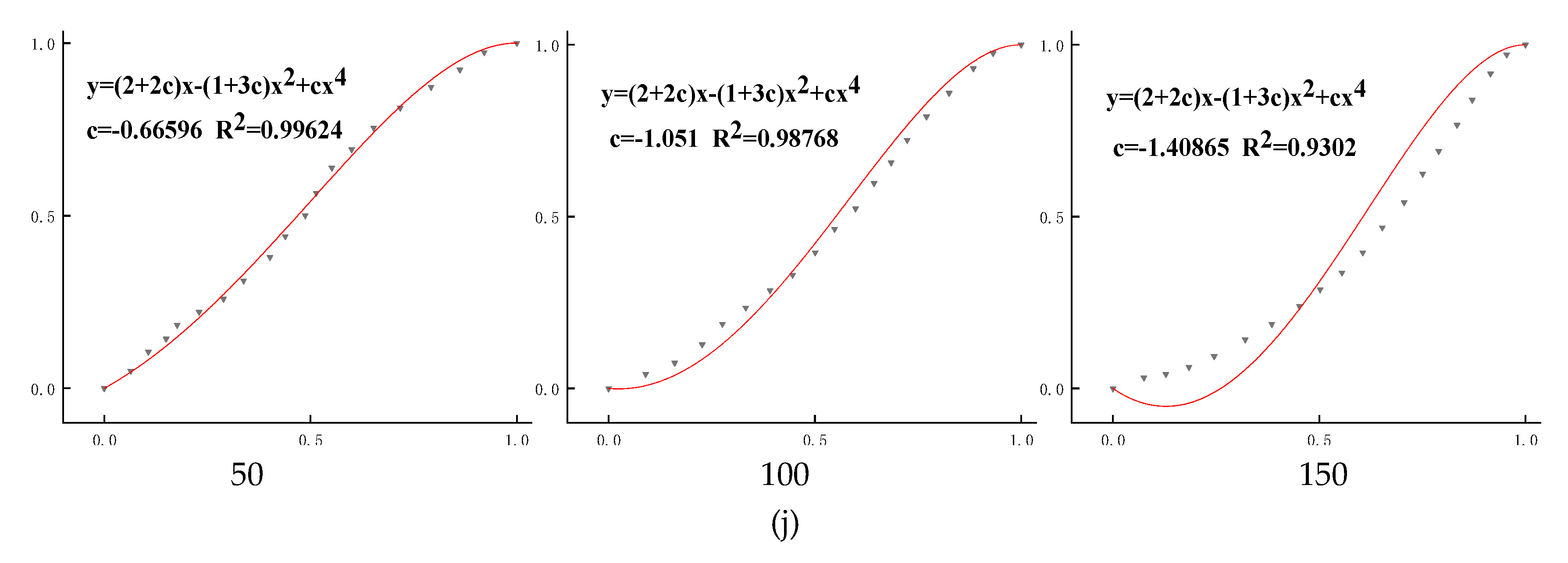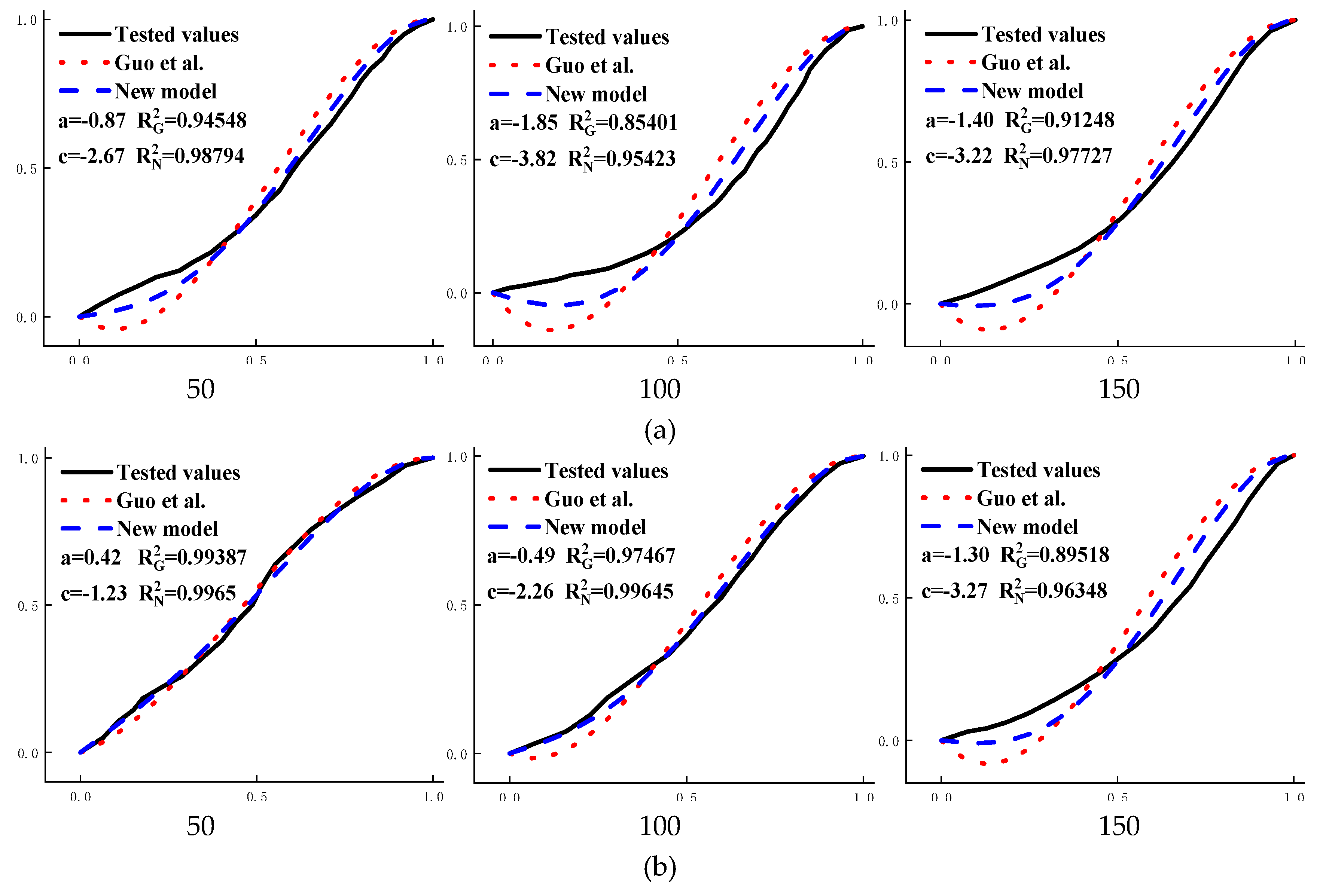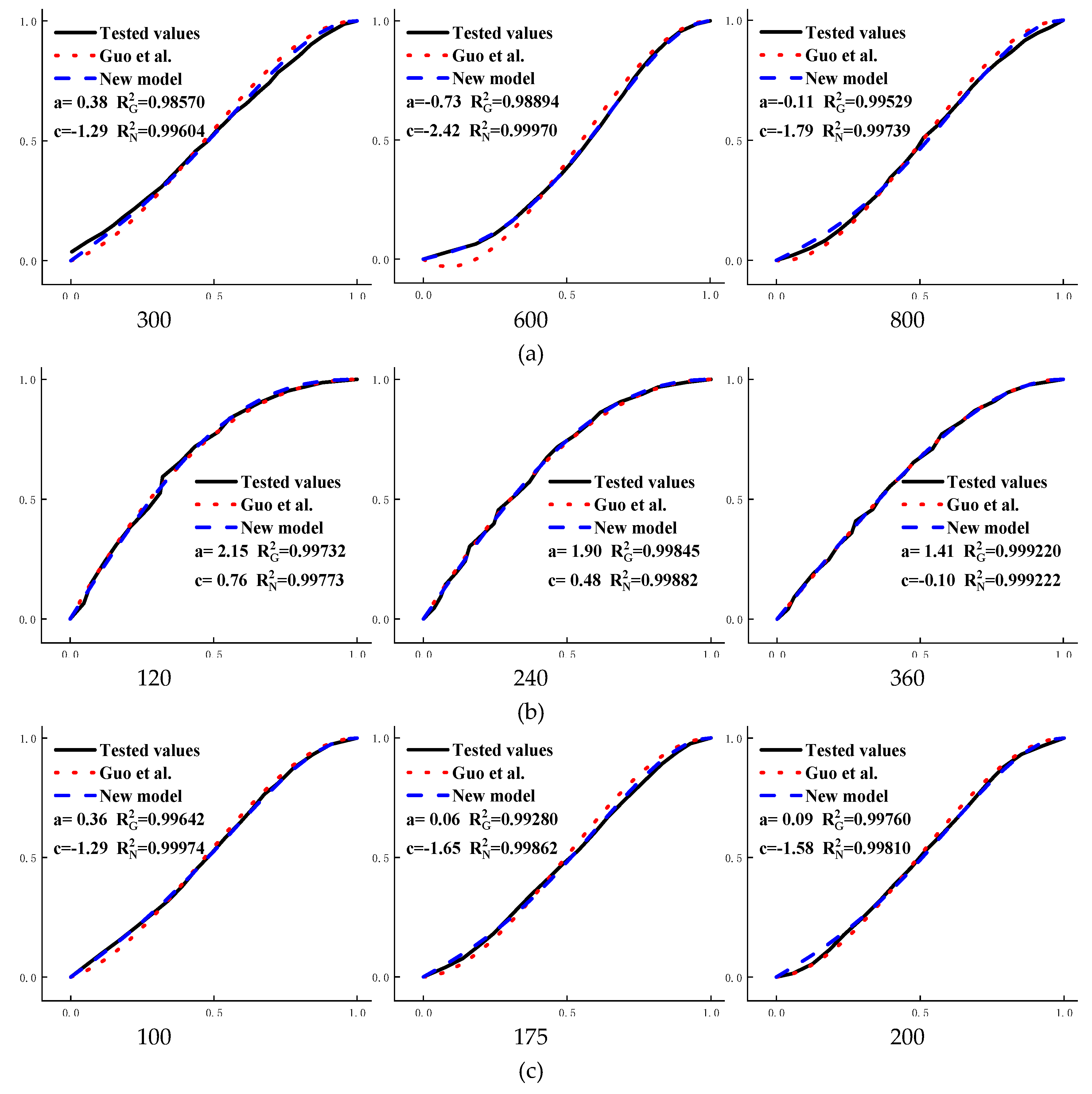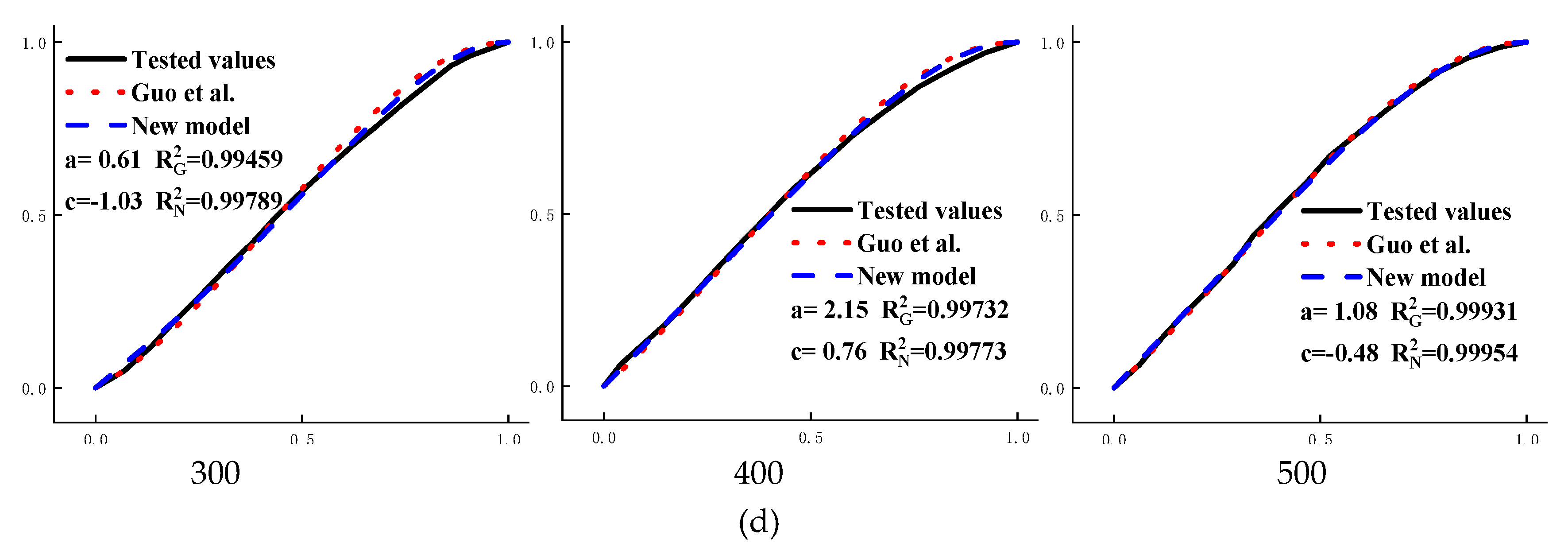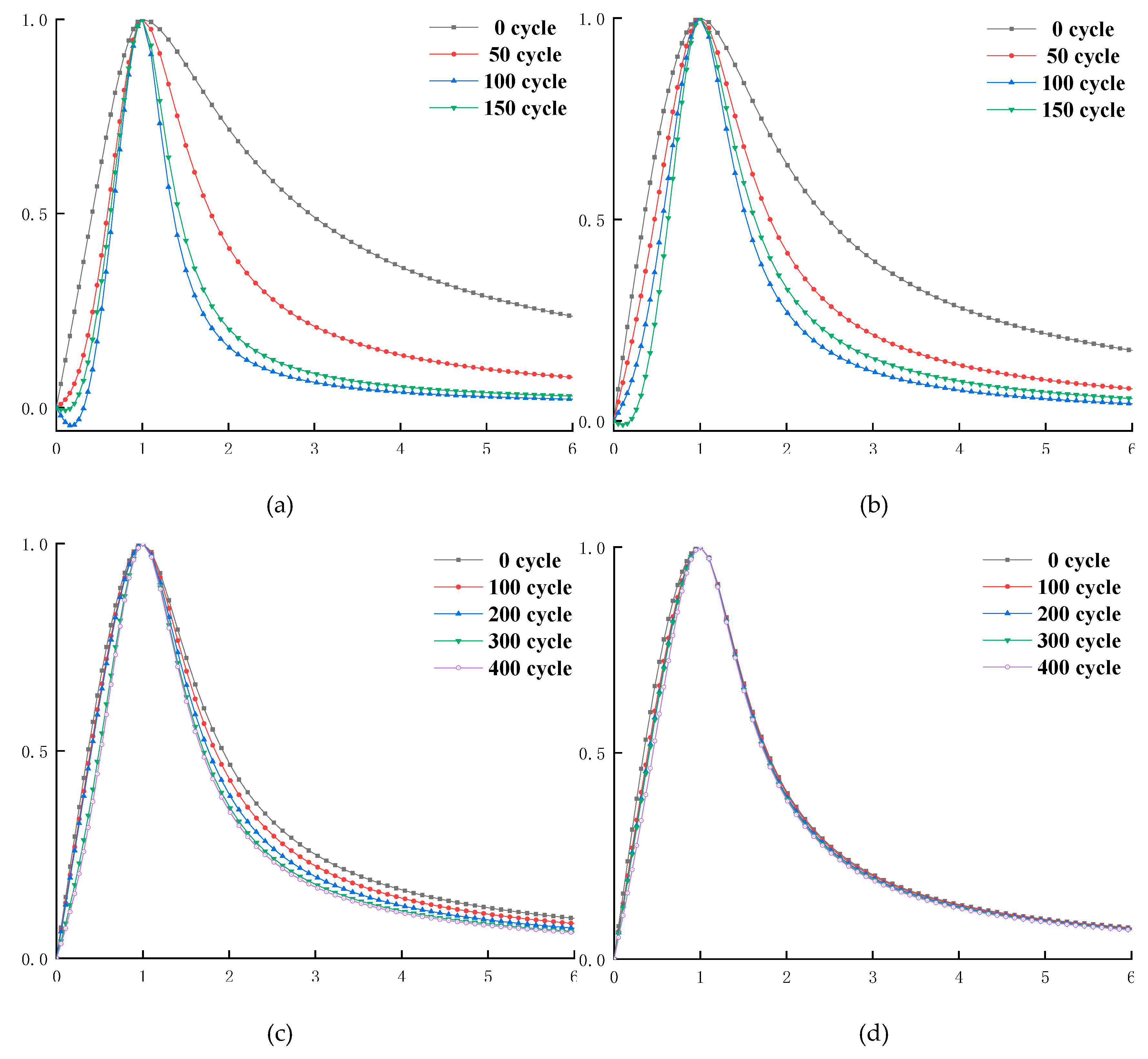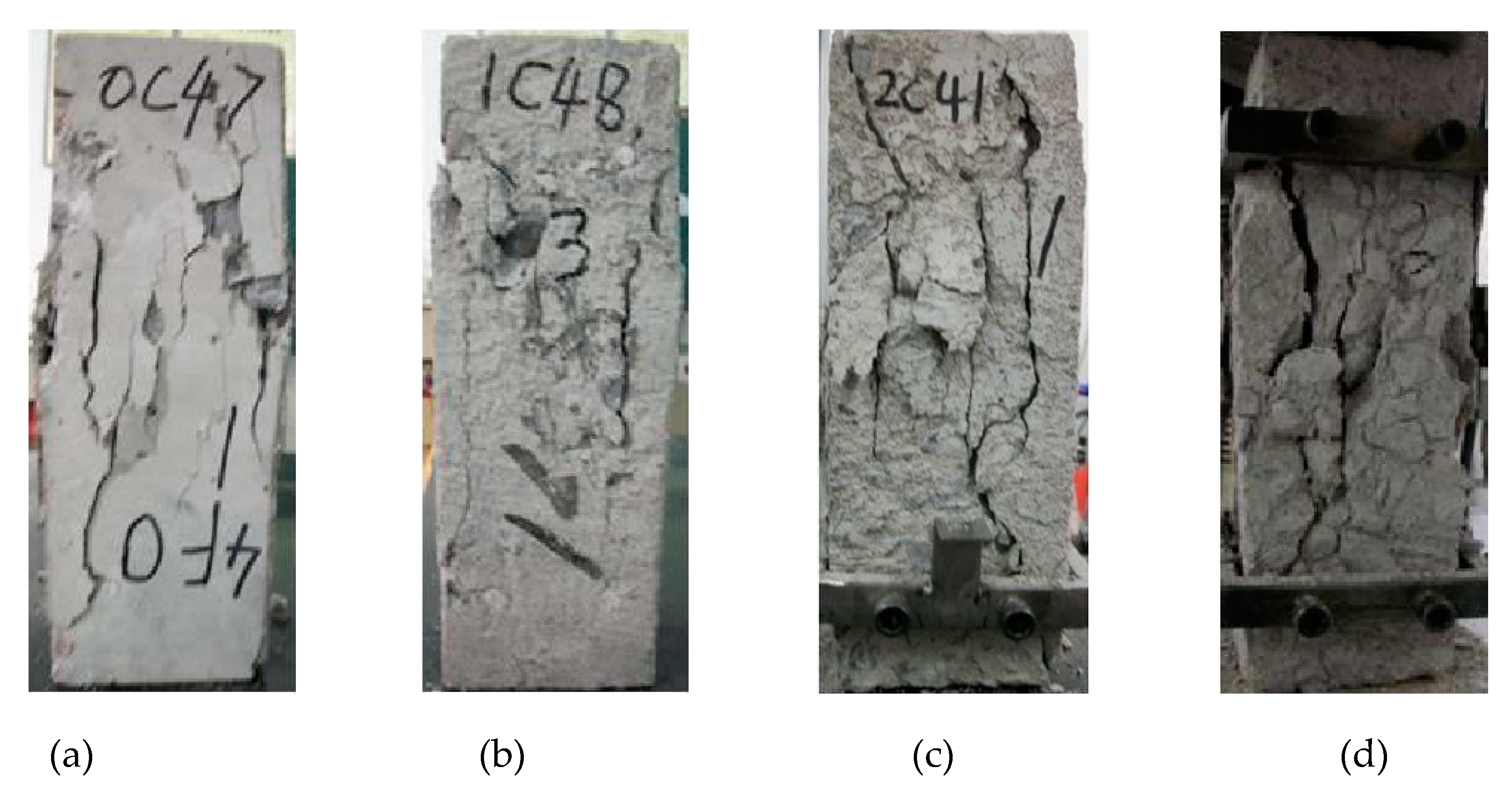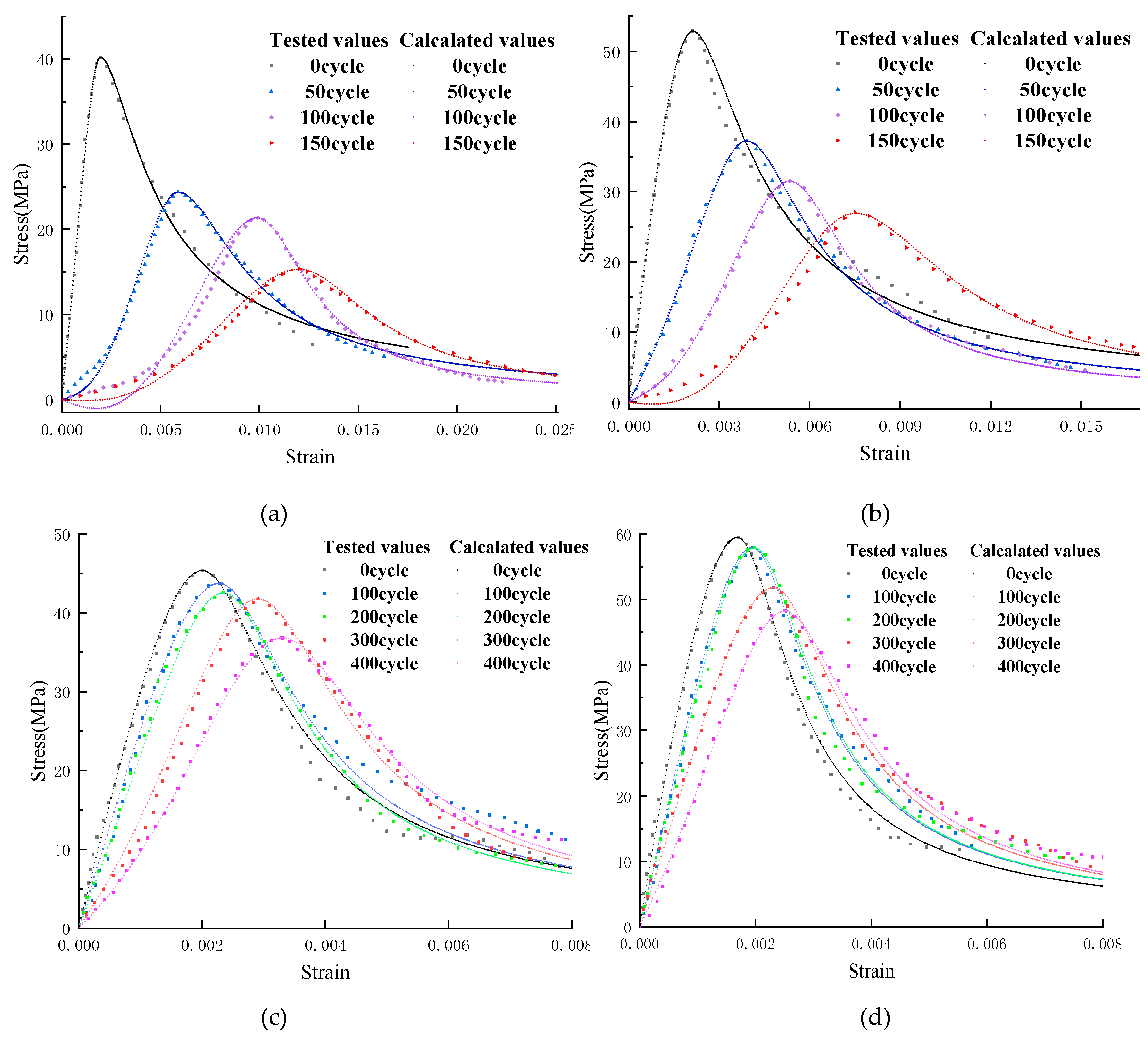4.1. Comparison of Fitting Results of Constitutive Models
Put the measured curve and the calculated curve or fitting curve in the same graph, so that their fitting degree can be observed. In order to prevent the accidental results of the fitting results, 50, 100, and 150 cycles of freeze–thaw cycles were conducted on ordinary C50 concrete. The results of stress–strain curves are shown in
Figure 5. The black triangle dot is the measured result, and the red line is the fitting result; dimensionless coordinates (
x = ε/εpr,
y = f/fpr,
xu = εu/εpr) are used in the figure.
Figure 5a–g shows the fitting results of Equations (1) to (7), respectively, and
Figure 5h–j shows the fitting results of Equations (11) to (13), respectively. Among them, the graphs of
Figure 5a–f are the fitting results of the complete stress–strain curve for concrete;
Figure 5g contains the fitting results of the ascending section and the descending section of the stress–strain curve; and
Figure 5h–j shows the fitting results of the ascending section of the stress–strain curve for concrete.
Figure 5 shows the fitting results of seven traditional constitutive models and three new constitutive models. It can be seen that the model of [
19], although simple in form and easy to calculate, has a large difference between the measured curve and the fitting result, and the fitting result is difficult to reflect the process of failure deformation and damage accumulation after the concrete is compressed. The fitting result of the ascending curve of the model of [
20] is the same as that of the model of [
19], which is different from the measured curve. This model can hardly reflect the change of residual stress and the plastic deformation process of concrete. Reference [
21] (Equation (3)) has too many parameters, and the parameter changes have no regularity to follow, so it is difficult to describe the change of the mechanical properties of concrete through the parameter values. The goodness of fit (
R2) is less than 0.94; the fitting results are quite different from the measured curve, which is also difficult to reflect the deformation and failure process of concrete under compression. The fitting results of [
21] (Equation (4)) have a high integration degree with the measured curve, and the goodness-of-fit results are all above 0.99, which can well describe the geometrical shapes of the stress–strain curve of concrete. However, there are too many parameters in the model, and the change of parameters are irregular; it is also difficult to describe the mechanical properties of concrete through the value of the parameters. The model parameters in [
22] are few and have clear physical significance, which can reflect the mechanical properties of concrete, but there are some differences between the fitting result and the calculated curve, so the mechanical properties of the concrete obtained through the parameter values are not accurate. The calculated curve of the model of [
23] is quite different from the measured curve. Therefore, it is difficult for this model to fit the shape of the stress–strain curve of concrete. Since the prism specimen is used in this paper, and the model of [
23] is applicable to the cylinder specimen. Therefore, there is some difference between the calculated curve and the measured curve.
Both the ascending curve equation and descending curve equation of the model of [
17] have only one parameter, which is easy to calculate; the parameters are independent of each other and have clear physical meaning, so they can fit the ascending curve and the descending curve. When the freeze–thaw cycle is 50 times, the measured results of the ascending section of the concrete constitutive curve has a high integrating degree with the fitting results, and goodness of fit is above 0.99. However, with the deepening of the deterioration of concrete, the difference between measured curve of the ascending section and the fitting result increases gradually; when the freeze–thaw cycle is 150 times, the goodness of fit is below 0.90, but it can still roughly describe the outline of the ascending section curve. The measured results of the descending section of the constitutive curve has a high integrating degree with the fitting results; the goodness of fit are all above 0.99, which can accurately reflect the plastic deformation process of concrete and the change of residual stress. The fitting results of the three new models have a high integration degree with the measured results; by comparing the goodness of fit, it can be found that the
R2 of the new model two is the highest and it also has the best fitting result. When the freeze–thaw cycle is 50 and 100 times,
R2 is as high as 0.9965 and 0.99645. Respectively, the fitting results are better than any one of the constitutive models. when the freeze–thaw cycle is 150 times, the deterioration of concrete is more serious, but the goodness of fit of the new model two is more than 0.96, indicating that the new model two can be used to “precisely” fit the rising section of the uniaxial compression constitutive curve of freeze–thaw concrete.
By comparison, it is found that the fitting results of the model of [
17] and the new model two have a high integration degree with the measured curve, at present, the fitting of constitutive curve of concrete under uniaxial compression is more accurate and popular by [
17].
Figure 5g shows that the fitting results of the descending curve fitted by the model of [
17] are relatively accurate, but under the same freeze–thaw times, the goodness of fit of the ascending curve section of the model of [
17] is less than that of the new model two. In order to compare the accuracy of the fitting results of the two models more reasonably, the stress–strain curve of 50, 100, and 150 times of freezing and thawing of ordinary C40 concrete (
Figure 6a) and ordinary C50 concrete (
Figure 6b) were selected, and the fitting results of the two models were compared in one picture, as shown in
Figure 6.
It can be seen from
Figure 6 that the ordinary C50 concrete with 50 times of freeze–thaw cycle has higher strength, the fitted results of the two models are almost seamlessly connected with the measured curve, and
R2 results are all above 0.99. As the deterioration of the concrete deepens, the degree of deviation between the fitting result fitted by the model of [
17] and the measured curve is gradually increase. When the freeze–thaw cycle was 150 times,
R2G (the goodness of fit of the model of [
17]) was less than 0.9. The fitting curve of the model of [
17] decreases first and then increases, meaning that the stress before the curve rises is less than zero. Therefore, it is obviously not in line with the actual law. The fitting result of the new model two gradually deviates from the measured curve with the deepening of concrete deterioration, but
R2N (the goodness of fit of the new model) is always higher than 0.96, and the fitting results always have a high integration degree with the measured curve. The fitting curve of the new model two is always surrounded by the fitting curve of [
17]. In the ordinary C40 concrete with low strength, the fitting curve of [
17] has negative stress areas. The maximum value of
R2G is only 0.94, and the minimum value is as low as 0.85, so the fitted result has severely deviated from the measured curve; the minimum value of
R2N of the new model two is 0.95, which is higher than the maximum value of
R2G and always keeps a high integration degree with the measured curve. There is almost no negative stress area in the fitting results, which is more in line with the reality. In summary, the new model two proposed in this paper has a high integration degree to the measured curve of concrete, and almost no negative stress areas appear and is more in line with actual.
4.3. Fitting and Prediction of Stress–Strain Curve of Concrete
The stress–strain curve of concrete under uniaxial compression is the most basic constitutive relation, which can fully reflect the strength, toughness, and ductile deformation of concrete materials, etc. Equation (19) is used to fit the constitutive curve of concrete under uniaxial compression; the value of the parameter can be used to reflect the mechanical properties of concrete by fitting the value of parameters, and can also study the evolution law of mechanical properties of concrete through the change of parameters. The fitting parameters
c and
b of the measured curve in
Figure 4 are shown in
Table 2.
As can be seen from
Table 2, with the increase of the number of freeze–thaw cycles, parameter
c of AE-concrete is gradually decreased, parameter
b is gradually increased, the curve becomes increasingly steep (
Figure 8), and the lower surrounding area becomes increasingly small. From the geometric definitions of
Section 2.7 and
Section 2.8, we can know that the materials of AE-concrete become brittle gradually, ductility and residual strength become increasingly low, and the failure process is increasingly rapid; this is consistent with the law of the gradual decrease of the mechanical properties of concrete obtained from the actual measurement results. Parameter
c of the O-C40 concrete with lower strength decreases first and then increases; parameter
b increases first and then decreases; and the curve steepens first and then slows down slightly, indicating that the ductility and residual strength of O-C40 concrete decreases first and then increases slightly. This is different from the law of gradual decrease of peak strength of O-C40 concrete. Parameter
b of the O-C50 concrete also decreases first and then increases, indicating that the law of ductility change is similar to that of the O-C40 concrete. In
Figure 6, the numerical change of parameter
a of the model of [
17] verified this phenomenon. In
Figure 7c, the change of
R2G also verified this phenomenon, which phenomenon can be seen in concrete with serious deterioration.
Figure 7c shows the freeze–thaw data of another article: Through the quantitative analysis of the new model and the model of [
17], it is found that the ductile deformation capacity of concrete decreases first and then increases slightly, which verifies the finding in this paper. Therefore, if the deterioration of concrete is serious, the deformation and flexibility of it does not decrease with the deepening on the deterioration of concrete, but decreases first and then slightly increases.
The ductile deformation capacity, plastic deformation capacity, and residual strength of ordinary concrete decrease first and then increase, so there must be a moment that the ductility and plastic deformation capacity of concrete are minimum. Take O-C40 concrete as an example to study the relationship between its ductile deformation capacity and the number of freeze–thaw cycles; its uniaxial compression failure process is shown in
Figure 8.
The change rule of the fitting results (
Table 2) indicates that the ductility and plastic deformation capacity of the O-C40 concrete is not completely reduced as the strength of the concrete decreases. As shown in
Figure 9a,b, this is due to the high compactness of concrete in the early stage of freezing and thawing. At this time, the strength and toughness of concrete are the best. In the process of uniaxial compression of concrete, the higher compactness and integrity support the higher ductility and plastic deformation ability of concrete [
33,
34]. In the late stage of freezing and thawing, the O-C40 concrete has been damaged many times by freezing–thawing, the internal structure of concrete is deteriorated seriously, and the compactness and strength of concrete are low. As shown in
Figure 9, the porosity and the degree of osteoporosis of concrete increase, and many micro-cracks appear. As the loading process progresses, the micro-cracks and loose parts of the concrete are closed by compression, showing a phenomenon of being compacted [
27]; under small stress, there will be large deformation. Therefore, the plastic deformation starts to accelerate, and the concrete breaks and produces many small cracks when the loading force exceeds its bearing capacity; although the concrete has been damaged at this time, due to its low brittleness, it will not break into several large blocks in an instant. However, the internal small crack gradually expands and penetrates, eventually forming a large through crack; the failure process of concrete is not rapid. As shown in
Figure 4, we can see the residual strength of the concrete after freeze–thaw cycle 150 times is higher than that of freeze–thaw 100 times. Therefore, the concrete still has certain ductility and plastic deformation ability in the later stage of freeze–thaw; in the middle of freeze–thaw, the porosity of concrete has increased, so its compactness and strength are lower than that of concrete in the initial stage of the freezing-and-thawing cycle, but higher than that of concrete in the later stage of freezing-and-thawing cycle. Due to the reduction of concrete strength, the toughness at this time is not enough to support sufficient ductility and plastic deformation of the concrete; also, because the concrete interior is not “loose” enough, the ductility and plastic deformation capacity of concrete are lower than that of late freeze–thaw. The brittle fracture of the concrete suddenly occurred during compression, forming multiple large cracks and breaking into several larger blocks, as shown in
Figure 9c; its ductility and plastic deformation capacity decreased rapidly with the fracture of the concrete specimens. At this time, the ductility and plastic deformation ability of concrete are the weakest, the residual strength is the lowest, and the failure process is the fastest. Therefore, there is a moment when the ductility and plastic deformation capacity of the concrete are the smallest during the degradation process. This paper names this moment as the minimum moment of ductile deformation capacity of concrete (MDC).
In order to obtain the stress–strain curve of concrete in any deterioration period, and then to predict and study the mechanical properties of concrete, and also to explore the corresponding freeze-and-thaw times of the MDC, the relationship among the peak stress, the peak strain, parameters
c in the ascending curve section, and parameter
b in the descending curve section were established. Moreover, the number of freeze–thaw cycles of O-C40 concrete, O-C50 concrete, AE-C40 concrete, and AE-C50 concrete specimens under the action of freeze–thaw cycle were established by using the least square method, as shown in Equations (20)–(23):
In Equations (20)–(23), fpr is the peak stress of concrete; εpr is the peak strain of concrete; b and c are model parameters; and N is the number of freezing and thawing.
According to Equations (20)–(23), the constitutive curve of freeze–thaw concrete in any deterioration period can be predicted.
Figure 10 shows the comparison between the predicted result and the measured result.
It can be seen from
Figure 10 that the predicted curve has a high integration degree with the measured result, indicating that this method can be used to predict the geometric shape of the concrete constitutive curve for any number of freeze–thaw cycles, and further study the changes of mechanical properties of concrete such as peak stress, peak strain, ductile deformation ability, and residual strength.
According to Equation (20), the minimum value of the parameter c of O-C40 concrete is −3.865 and the corresponding number of freeze–thaw cycles is 111.42, the maximum value of the parameter b is 11.735 and the corresponding number of freeze–thaw cycles is 118.63, indicating that the MDC of the ordinary C40 concrete is about 111–118 times of freezing and thawing. According to Equation (21), the maximum value of the parameter b is 5.636, and the corresponding number of freeze–thaw cycles is 115.86, indicating that the MDC of the O-C50 concrete is about 116 times of freezing and thawing.
In the study of this paper, the MDC only appears in ordinary concrete, but this phenomenon does not occur in air entraining concrete. The reason is that the ordinary concrete deteriorates faster; the compressive strength of O-C40 concrete and O-C50 concrete suffering 100 cycles of freezing and thawing decreased by 0.48 and 0.40, respectively, compared with that of unfreezing–thawing concrete, while that of AE-C40 concrete and AE-C50 concrete suffering 400 cycles of freezing and thawing decreased by 0.19 and 0.17, respectively, compared with that of unfreezing–thawing concrete. Therefore, the MDC usually occurs when the sample is damaged seriously, at this moment, the ductile deformation capacity of concrete is the weakest, the damage process is the fastest, and the concrete instantly break into several larger test blocks. Therefore, in practical engineering, we should not only pay attention to the change of concrete strength, but also the MDC, because once the concrete is destroyed when its ductility is the weakest, the damage speed of concrete is difficult to control and the loss is immeasurable. At present, the MDC can only be obtained by using the computing method in this paper. In the future, the research of the construction curve should pay attention to this aspect of the MDC, and it is also important to develop a more accurate forecasting methods for the MDC.
It can also be found in
Figure 3 that the mass loss of concrete has not decreased to 5% and the relative dynamic elastic modulus has not decreased to 60% during the number of freeze–thaw cycles 100–150, but the MDC arrived, and the compressive strength of O-C40 concrete and O-C50 concrete also decreased by more than 0.48 and more than 0.40, respectively. It is obvious that during this period the compression concrete is prone to brittle fracture. Therefore, the evaluation of the frost resistance of concrete under low temperature or freeze–thaw environment cannot only refer to the changes of physical macroscopic index, and also should include the research of ductility deformation ability and mechanical index of concrete, in order to meet the requirements of safety assessment.
